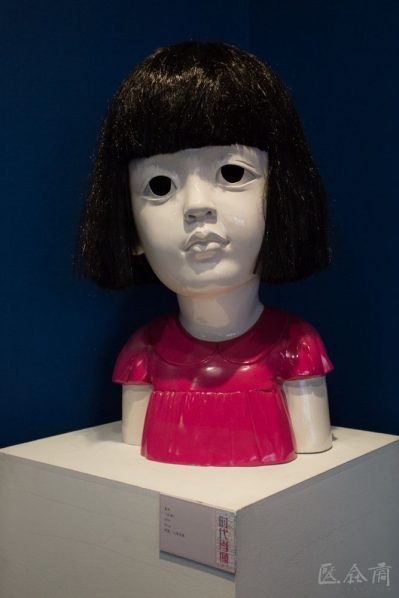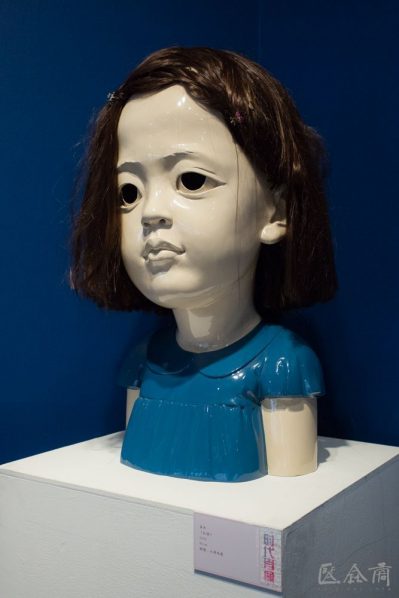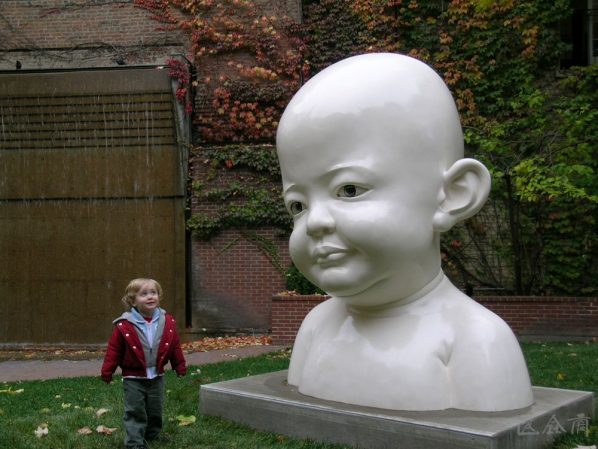
Exhibition view of the “Portraits of the Times”
In mid-January, the “Portraits of the Times”, a large-scale exhibition covering various artistic expressions including Chinese painting, oil painting, printmaking, sculpture, and photography, was held at the Imperial Ancestral Temple. The use of a variety of forms and language expressions that represent the historical figures and famous contemporary figures in various fields including Chinese politics, culture and art, and also selected thematic creations for the model workers of different generations, so that the audience can have a glimpse of the development of Chinese culture and the spirit of Chinese culture in different eras. Jiang Jie brought us a group of works entitled “Red Child”, with a theme and style that is different from other portraits. During the exhibition, CAFA ART INFO interviewed Prof. Jiang Jie from the Department of Sculpture of the Central Academy of Fine Arts, who started from the concept of the work, the relationship between contemporary sculpture and traditional sculpture, the difference between sketching and creation, and the history and status quo of the sculptural portrait creation, then expounded her understanding of the portraits of the times, sculptural portrait creation and even the contemporary sculpture.
Interview Time: March 2, 2018
Venue: Department of Sculpture, Central Academy of Fine Arts
Interviewer and Copywriter: Yang Zhonghui
Interviewee: Jiang Jie
Translated by Chen Peihua and edited by Sue/CAFA ART INFO
CAFA ART INFO: This exhibition presents your work entitled “Red Child” in the exhibition and Yu Hong also displays a portrait of oil painting of the same name. She took her daughter as a model for the painting, what is the source of your work? First of all, please expound your work for us.Jiang Jie: The “Red Child” series of works was finished in 2006. At that time, I was preparing to make a series of statues of mothers and daughters or mothers and sons, who were similar to each other, and even the statues of fathers and daughters or fathers and sons, in order to reflect the genetic relationship of human beings. I have looked for some pictures and also observed some friends. I found that the strong genes of mothers or fathers were inherited by their daughters or sons, such as a girl is like her mother, or a boy is like his father. Genetics are related to inheritance, but what exactly is a gene and what is inheritance? I have always thought that it is interesting to think of these issues. “Red Child” takes Yu Hong and her daughter’s photos as the creative material. Based on the similarities of the appearances of the mother and daughter, I created two pieces dressed in red and blue. They were both made from the same mold, while the hairstyles and clothing changed. It was designed to make a series at that time, but this group of works was unfortunately interrupted due to various reasons.

Jiang Jie, Red Child, resin, spray paint, artificial hair, 80 cm, 2006
Jiang Jie: I think the scope of the “Portraits of the Times” is wide, and it neither restricts a theme, nor demands monuments or celebrity portraits. The “Portraits of the Times” is certainly related to the present. Our thinking on some issues is communicated through portrait creation. In fact, I think that any portrait can be on show at this exhibition from this perspective, but I have only created a few portraits, such as “Red Child” and “Zai” (2001), which are suitable for this exhibition. I finally chose “Red Child” due to the limitation of the venue. This group of works use artificial hair as the material, and it is no longer a traditional clay-molding method in terms of shaping, eliminating traces of handmade and other traces. It applies a method that is similar to making a doll by machine.
CAFA ART INFO: The group of “Red Child” tends to be conceptualized, but it has its own image source. I have seen that you have created other series of works that resemble dolls produced by industry, are there any sources of these works? How do you deal with the relationship between sketching and creation in your work?Jiang Jie: I consider sketching as a way of training. For example, the Department of Sculpture arranges the training course in the sketching of models, where students’ creations have a strong sense of sketching. However, they are engaged in creation after graduation. The difference between working and training is that training involves studying some methods. Students through the sketching training resolve the basic problems such as their favorite form, methods of expression, and the problems that you want to solve, as well as the shaping systems and skills. But as an independent creator, you have to create a work and think of how to express and communicate ideas. The model is only a medium for us to communicate our ideas, so that, whether it is my portrait works of “Zai” or “Red Child”, or some of my other figurative works, they have been infused with my concept.

Jiang Jie, Red Child, resin, spray paint, artificial hair, 80 cm, 2006
Jiang Jie: The Department of Sculpture is divided into seven studios and the teaching focus of each studio is different. I worked in the 3rd Studio that focuses on the creation courses rather than portrait shaping, and it highlights the material experiments and conceptual training.
CAFA ART INFO: As a traditional art expression, it is difficult for sculpture to enter modern times. You studied realistic sculptures when you were a student in the Central Academy of Fine Arts, but your sculptures have been changed to be contemporary since you created a series of works and participated in the exhibition of “Sculpture 1994” in 1994. From the perspective of materials, you have shifted from the use of traditional hard materials such as copper, iron, wood, and stone to start using some soft materials such as paper, wax and gauze, as well as resin, artificial hair, etc. which are used in this exhibited work. Would you like to share with us the process of transition and transformation from the traditional to contemporary?Jiang Jie: In the traditional concept, sculptural materials should be permanent and sturdy, but with more emphasis on the work itself in contemporary art, though works do not limit the material. The traditional concept of “what is a sculpture and what is not a sculpture” has begun to change, so sculptures are not only molded in clay. Many sculptural works are created based on various materials in contemporary art and this is universal. For students, they may think that the choice of sculptural materials is narrow at the beginning, but it does not have a limitation of use and there can be changes in the materials in the future. After entering contemporary art, you will find that no matter what method you use or what kind of modeling method you use, it is not important. It is important to know what you want to do, what the work conveys and communicates. Whether it is a smooth surface or a non-smooth surface, it is not an important thing. It is important to tell people why you use these things. Think of the thing that you need in your creation and think of the thing that makes you achieve the expected result, and then use it. I also teach my students this idea in my teaching.

Jiang Jie, Zai, resin, paint, glass, 200 x 160 x 140 cm, 2001
Jiang Jie: Sculptural portraits are all realistic in the traditional art field, but now portraits are varied. The portraits are also varied in the paintings. Many artists create abstract pieces, and you can’t clearly see what it is, but it is actually a spirit. The current “portrait” does not have a strict definition, and there are non-figurative portraits in the sculptures. In addition to paintings and sculptures, portraits appear in the images and pictures and the forms of various portraits can become art, so that, the scope of present portraits has been widely expanded.
CAFA ART INFO: For ancient sculptures, whether they are the beasts guarding tombs or Buddha statues, they have a strong ritual sense and functional significance. Since the founding of the People’s Republic of China, the functionality of sculpture has been extremely strong. What do you think of the functionality of contemporary sculpture, such as this group of works?Jiang Jie: Everyone pays attention to different aspects of contemporary art. It can’t be said that contemporary sculpture does not have functionality, nor is it functional. I think it depends on the needs of the whole work. Contemporary sculptures are diversified, and the sculptural meaning of many public spaces has also been expanded. In addition to the well-known Monument to the People's Heroes, the sculptures of various battles collected by museums, and some sculptural thematic parks, the forms, themes and materials of sculptures have become diversified. Western contemporary outdoor sculptures are more diverse and diversified. The biggest difference between contemporary sculpture and painting is that it can be both placed indoors and outdoors. People can enter and participate in it, which needs sculptors to think of how the audience participates and enters an exhibition when the artist is creating.
CAFA ART INFO: Speaking of the portraits of the times, the “times” always reminds people of the main theme of Chinese images and Chinese faces, therefore, the word “times” give people a feeling of the national ideology, or carrying a unified will? Do you have this feeling? How do you see the influence of the times and society on an artist?Jiang Jie: I have never considered this problem, because I think an exhibition is only an exhibition, and it is entitled by the curator. The works which are created by the people who live in the times should be called contemporary pieces. It has a relationship with this era, and the problems that you are considering are also placed in the background of the times. It must rigorously choose works for a solo exhibition, but I will not create a new piece for a group show, and I would like to present a work created previously, so I do not have a strong feeling.




























